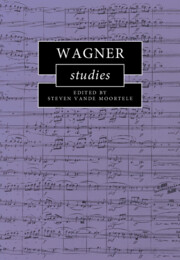Book contents
- Wagner Studies
- Cambridge Composer Studies
- Wagner Studies
- Copyright page
- Contents
- Figures
- Tables
- Music Examples
- Notes on Contributors
- Introduction: Analysing Wagner
- Part I Orientations
- Part II Form, Drama and Convention
- 3 Wagner and the Uses of Convention? La solita forma from Die Feen through Lohengrin
- 4 Elsa, Ortrud, the Grail and the Forbidden Question: Formal Functions and Rotational Form in Lohengrin
- 5 Scena, Form and Drama in Act 1 of Die Walküre
- Part III Time, Texture and Tonality
- Part IV Reception
- Bibliography
- Index
3 - Wagner and the Uses of Convention? La solita forma from Die Feen through Lohengrin
from Part II - Form, Drama and Convention
Published online by Cambridge University Press: 17 April 2025
- Wagner Studies
- Cambridge Composer Studies
- Wagner Studies
- Copyright page
- Contents
- Figures
- Tables
- Music Examples
- Notes on Contributors
- Introduction: Analysing Wagner
- Part I Orientations
- Part II Form, Drama and Convention
- 3 Wagner and the Uses of Convention? La solita forma from Die Feen through Lohengrin
- 4 Elsa, Ortrud, the Grail and the Forbidden Question: Formal Functions and Rotational Form in Lohengrin
- 5 Scena, Form and Drama in Act 1 of Die Walküre
- Part III Time, Texture and Tonality
- Part IV Reception
- Bibliography
- Index
Summary
This chapter demonstrates that despite Wagner’s claims that traditional operatic compositional schemes limited the composer’s ability to project drama successfully, he relied on these procedures in the operas from Die Feen through Lohengrin, and continued to use them thereafter in the mature music dramas. Analysis of Wagner’s first six operas demonstrates that Wagner utilised the formal conventions of Italian opera, including clearly articulated cabalettas, far more frequently than has previously been noted. The conventional Italian form accounts for one-third to one-half of musical numbers in these works. The chapter includes close analysis of four numbers (from Die Feen, Der fliegende Holländer, Tannhäuser and Lohengrin) and tabular presentation of all of Wagner’s appropriations of this formal convention in the first part of his career. The chapter further identifies vestiges and transformations of la solita forma in the later music dramas, concluding with speculation on why these formal devices have eluded critical commentary until now.
Keywords
- Type
- Chapter
- Information
- Wagner Studies , pp. 51 - 66Publisher: Cambridge University PressPrint publication year: 2025

